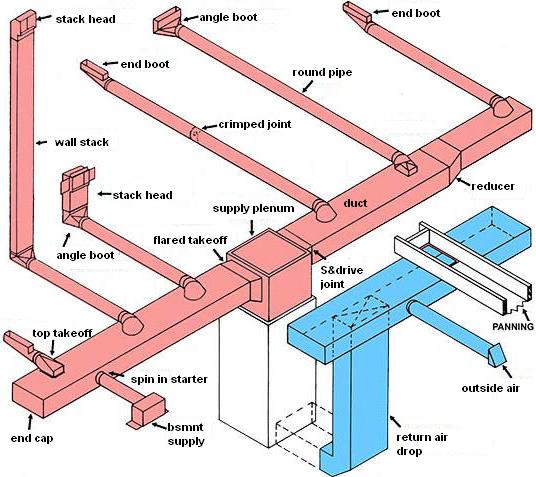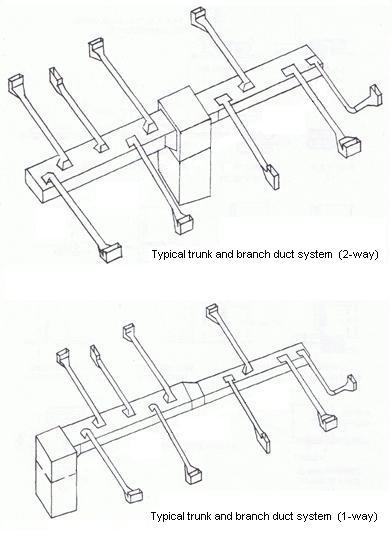|
HVAC FOR BEGINNERS
| |||||
|
|
The three example systems pictured on this page are all typical upflow configuration, which comprise about 85% of forced air systems in our homes. Other fairly common systems can be underslab or crawlspace, with a counterflow (or downflow) air handler, attic or crawlspace systems with a horizontal air handler. The ducting is actually quite similar.

Basic Duct System Components
- Supply Plenum - usually on top of air handler for the initial distribution of conditioned air through connected ductwork.
- Return Air Drop - brings air from living space to air handler for conditioning and re-distribution.
- Flared Rectangular Take-off - connects to plenum to start ductwork.
- Reducer - usually 3 or 4 supply branches are connected to main trunk before a reducer changes duct size. Can be rectangular, square, or round.
- Top Take-off - connector for round branch lines to connect to main supply trunk. Can be square-to-round, oval-to-round, or round-to-round. Often are used as side take-offs also.
- Boots - delivers conditioned air into living space and houses the register.
- Stack head - a boot for a wall register.
- Wall stack - ductwork inside a wall to feed a stack head.
- Panning - flat metal nailed to joists for return air.
- Outside Air - Often a free flowing outide air is tied into the return ducting to keep some fresh air introduced into the residence. In extreme climates this ducting must be insulated, or condensation will occur.
Organizations governing Hvac design, installation, and ductwork standards are
ACCA
,
ASHRAE
, and
SMACNA.
(click to visit their sites)
Other Related "Hvac for Beginners" Pages
Residential Hvac Duct Drawings
- by Geoffrey Stoddard, Detroit, Mich.
Plenums and Return Air Drops
Duct Fittings: Ells, Tees, and Reducers
Rectangular Side Take-offs and Vertical Ells
Multiple Fittings in a Duct System
Basic How-To Ductwork Installation
Return to Duct Design main page
Leave this "Hvac for Beginners" page and Return to HOME
Please feel free to link to this page from your website. This page's URL is: http://www.perfect-home-hvac-design.com/hvac-for-beginners.html











